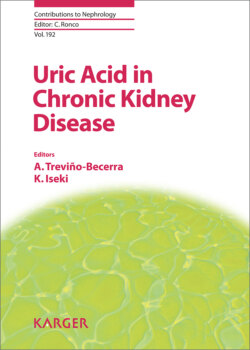Читать книгу Uric Acid in Chronic Kidney Disease - Группа авторов - Страница 24
На сайте Литреса книга снята с продажи.
Hyperuricemia and Chronic Kidney Disease
ОглавлениеChronic urate nephropathy was primarily seen in the past in patients with tophaceous gout. However, it is currently thought to be uncommon and some feel that the diagnosis cannot be made on clinical grounds in the absence of renal biopsy [10]. Most studies documented that an elevated serum uric acid level independently predicts the development of chronic kidney disease (CKD). The specific mechanism(s) by which uric acid may be causing these effects has been studied. One of the more striking findings is that uric acid is a prooxidant inside the cell where it can induce stimulation of NADPH oxidases with the induction of mitochondrial dysfunction. Uric acid can also induce endothelial dysfunction via a variety of mechanisms. In addition to the effect already commented on vascular smooth muscle cells with the production of chemotactic and oxidizing factors and the activation of RAS [11].
The role of uric acid in the development and progression of CKD has been evaluated by several epidemiological studies. There is evidence that elevated uric acid concentration may be a predictor of progression, especially in diabetes and IgA nephropathy [12].
In diabetes, serum uric acid is often low because of the effects of glycosuria in increasing urate excretion. As a result, it is possible to find a low serum uric acid level in subjects with uncontrolled glucose. In subjects with type 1 diabetes, an elevated serum uric acid level, even when within the normal range, is a strong predictor for the development of both incipient (microalbuminuric) and established (albuminuric) diabetic nephropathy. It also predicts the development of CKD, the development and progression of CKD in subjects with type 2 diabetes [13, 14].
In chronic urate nephropathy the deposition of sodium urate crystals in the medullary interstitium is appreciated. This results in a chronic inflammatory response, similar to that seen with microtophus formation elsewhere in the body, potentially leading to interstitial fibrosis and CKD. Although urate crystals in the renal medulla are demonstrable on biopsy, the clinical features of chronic urate nephropathy are nonspecific: renal functional impairment, bland urinary sediment, mild proteinuria, and serum urate concentrations are often higher than expected in terms of the degree of impaired renal function. Nevertheless, it is difficult to separate hyperuricemia from the other causes of renal impairment that can occur in patients with hyperuricemia, such as hypertension and diabetes mellitus [15].
